I used to own an odd little dual sport called the Sherpa Sherpa and – as often happens with odd little things one gets to like – I stupidly sold it before I realized how much I liked it.
The Sherpa is a dual 250 cc dual sport motorcycle made by Kawasaki that came out – in the Japanese home market – in 1997 and in the United States in 1999. It was sold through 2003 here (and continuously in Japan and other markets) and then again in the United States in 2009.
My bike was a 2000.
It’s a fairly rare bike, but there’s a devoted, if small, owner’s society out there.
(See here for one of the many KL/KLR owners’ forums/)
The KL250 weighs 282 pounds, has a tube steel frame with an aluminum swingarm and “Uni-Trak” monotube/coil shock rear suspension. The engine is 14.5 hp DOHC air-cooled single. The transmission is a six-speed w/cable-actuated (non-hydraulic) clutch. It features a digital dashboard with twin tripmeters and clock, but no tachometer, temperature warning light/gauge or gas gauge.
New MSRP was $4,999. I picked mine up with less than 2,000 miles on it back in 2004 for $2,000.
Many people confuse the KL250 with the more popular KLR250, but they are very different bikes even though they’re about the same size and even look similar from 20 yards out.
The Sherpa is more on-road oriented than the KLR – at least, as it comes from the factory. For example, the KL250 has street-intended tires that are helpless as Ned Beatty in Deliverance on anything more challenging than gravel. It also comes with a low-mount front fender. The original/factory chromed aluminum handlebar is also fairly delicate and can be easily bent if you drop the bike off-roading. The turn signals do have flexible stalks but they, too, are easy to damage when riding off-road.
One of the first things I did to my bike was to install the high-mount front fender and replace the street-minded factory tires with much more aggressive “90-10” (90 percent off-road) knobbies. I swapped out the factory handlebar, replacing it with an aftermarket (reinforced) tube-steel type that’s much tougher and also a little shorter, for clearance off-road. Finally, I replaced the street-oriented (and chromed) factory rearview mirrors with flexible plastic off-road mirrors. (The turn signals/stalks can be easily unplugged prior to riding if you head off-road. This, in my opinion, is the best solution for that issue.)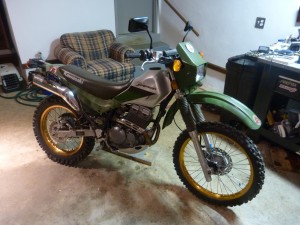
These minor mods made the bike much more off-road capable without screwing up its on-road capability (or legality).
Functionally, one of the major differences between the KL250 and the KLR250 is the engine. Both bikes have 250 cc singles but the KL’s single is air-cooled vs. the KLR250’s water-cooled engine.
I am partial to the air-cooled engine of the KL because they’re inherently simpler – and also inherently lower-maintenance. There’s no radiator to hole when you’re out in The Woods – and you never have to worry about replacing coolant or bursting a hose.
It’s true the KLR’s water-cooled engine makes a bit more power and handles high-heat summer days better – but the KL will still do 100-plus all out – and it can maintain 60 MPH with a 200 pound rider (me) on board. It’s actually pretty quick off the line and feels stronger over 50 mph than the KLR.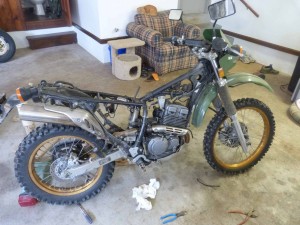
I think the KLR250 has “gruntier” gearing – and a slightly lower top speed – which would make sense for a bike designed to spend most of its not on pavement.
A weak point is the hyper-lean factory jetting, done for emissions – to placate the government. This makes the KL250 very cold natured and hard-starting if the air temp is less than 40 degrees. The good news is this is easily (and inexpensively) taken care of by swapping out the lean pilot and main jets with richer ones (use a 130 main, Kaw part #KW92063-1103 and pilot jet #45-20) and removing the brass air screw limiter, then setting the air screw to 2 and 3/4 turns out.
I did this the first month I owned my bike and it made a tremendous difference for the better.
Another difference between the KLR ad the KL is the frame – and seat height. The Sherpa is a physically smaller bike than the KLR and you sit much lower in the KL (seat height is 32.7 inches). This is a plus for shorter riders as well as new riders. But taller riders (I’m 6 ft 3) can still comfortably ride this bike, too.
A big downside (off road) is that the KL’s suspension has less travel than the KLR’s – and if you are a heavy person (over 150 pounds) or ride aggressively off-road, the bike will bottom out more easily and the ride is definitely harsher.
Another difference: The KL250 has disc brakes front and rear whereas the KLR (older models, at least) has a drum rear brake. Having ridden both, I can vouch that the KL stops quicker and has better braking feel.
Another KL feature is the gold-anodized (and spoked) rims. They’re nice-looking and also expensive looking.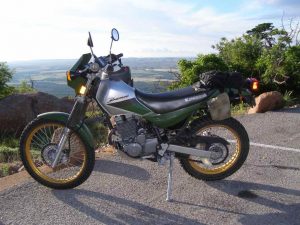
A downside is you’re limited in terms of the width of the rear tire you can mount because the KL250’s swingarm has less space between its bars than the KLR’s. I have a friend who owns a circa 1997 KLR250 and he was able to mount a much wider off-road tire than I could. But in real-world off-road use I have found that the KL will absolutely keep up with a KLR using the same tire – even if the KLR’s is larger. I have taken the KL down some scary trails where I live up in the Blue Ridge mountains – and the bike got me down and back as well as my buddy’s KLR. It has tackled stream wading and two feet of snow. It’s a tough, tenacious little thing.
There’s only one thing I about the KL250 I really don’t like – and which I consider a liability for an off-road bike : It has electric start, without a kicker back-up.
The KLR250 has a kicker – period.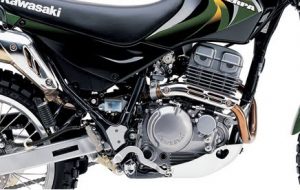
I prefer a kicker, regardless – but for off-road bikes, I think a kick-starter is a must-have.
Anyone who goes off-roading knows this scene: You’re deep in The Woods and just rode through a puddle you thought was three inches deep that turned out to be three feet deep. The bike stalls out. You heave it out of the muck, pull the spark plug and rotate the engine to clear the water out of the engine. Then you reinstall the plug and restart it. If it’s electric, you may only have a few seconds of juice – maybe none at all, if the battery fried out.
If it doesn’t light, you’re pushing.
At least until you find downhill stretch and roll-start the thing. Maybe there’s no hill.
But if you have a kicker, you’ll be riding again. It may take awhile and your leg may get sore, but so long as you can kick that thing, eventually, it will light off – and you won’t have to push it.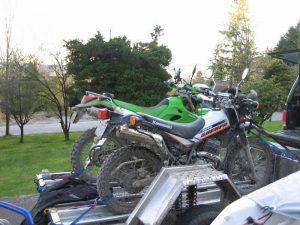
Or go get your truck.
When I got my bike, I spent a lot of time researching whether it would be feasible to retrofit a kicker. There is a plug on the side of the engine case where a kicker lever would go (it looks like). But after asking a lot of questions, I found out that doing this mod would involve a lot more work and money than I was willing to throw at it. Instead, I always made sure the battery was fully charged before I even think about going off-roading and I never ride in The Woods alone, just in case. Having to hump it several miles out of the wilderness because the bike won’t start is a even better than Captain Freedom’s Workout, though.
What else?
One of the Sherpa great virtues is that it requires very little upkeep. It takes 1.6 quarts of oil (w/filter change) and both the drain plug (underside of the case) and the filter access (under a cover on the righthand side of the bike; just unbolt two 10 mm bolts) are easy to to get at.
An oil/filter change takes less than 10 minutes and costs under $10.
There’s no radiator, so no leaks. And no coolant to change or hoses to sweat. Other than periodic chain tension checks/adjustments and a valve clearance check every 7,500 miles or so this bike doesn’t ask for much. It gets 60-70 MPGs, depending on how it’s set up (expect mileage to drop with off-road knobbies and jetting, etc.) and is extremely reliable. I ran worked mine like a Dickensian teenager in a tin mine – including sustained WOT runs at top speed for ten minutes at a time and and nothing went kablooey.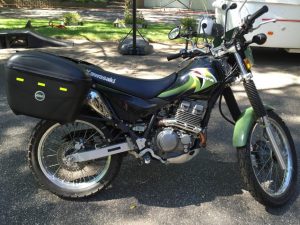
The KLR is the better hard-core off-road bike, mainly because of its superior clearance and suspension travel. But the KL is a bike that can do 90 percent of what the KLR can in real-world off-roading (unless you motocross) and it’s a better bike on-road that costs less to keep, too.
It’s also a better choice for a first bike/learner bike because it’s not too tall and has an easier-going nature – but it isn’t too small or underpowered to be your bike after you learn how to ride. It’s an excellent commuter bike that’s also a rugged trails bike still able to knock around local roads and keep up with highway traffic, if you need to.
If you can find one, you will probably find you’ll like it as much as I did.
. . .
Got a question about cars, Libertarian politics – or anything else? Click on the “ask Eric” link and send ’em in!
If you like what you’ve found here please consider supporting EPautos.
We depend on you to keep the wheels turning!
Our donate button is here.
If you prefer not to use PayPal, our mailing address is:
EPautos
721 Hummingbird Lane SE
Copper Hill, VA 24079
PS: Get an EPautos magnet or sticker or coaster in return for a $20 or more one-time donation or a $10 or more monthly recurring donation. (Please be sure to tell us you want a magnet or sticker or coaster – and also, provide an address, so we know where to mail the thing!)
My latest eBook is also available for your favorite price – free! Click here. If that fails, email me at EPeters952@yahoo.com and I will send you a copy directly!


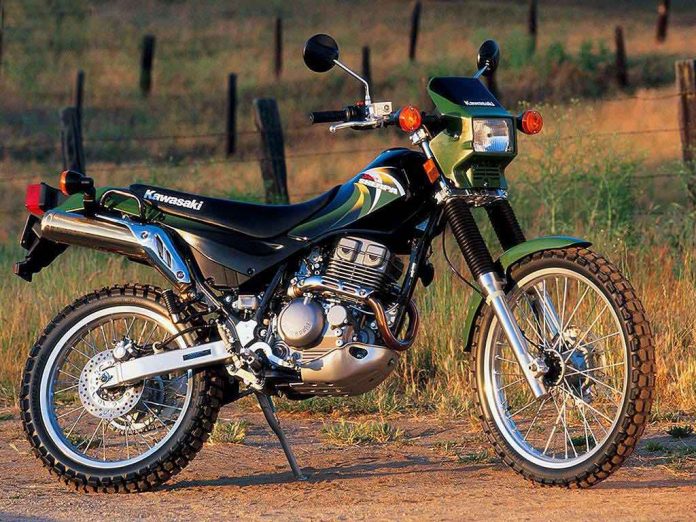


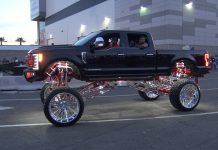

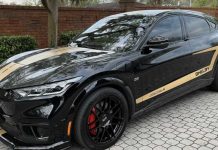



Sorry you sold the Super Sherpa. they getting hard to find for a good used one. I mentioned that we have 3 bikes for my sons and I but my son wrecked one when a car pulled out of a parking lot in front of him. I would advise against Dairyland Motorcycle Insurance. They are worthless. Roger
If you think you like the Super Sherpa now, you should come out to Utah and ride the slick rock trails in Moab and other spots. It is the perfect bike for on road/off road. At home in Layton Ut we ride the highway for a few miles and straight up the trails without even slowing down. No trailers. We have three of them for my sons and I. Don’t want anything else.
Hi Roger,
Sadly, I sold mine… divorce will do that to a guy. But I hope one day to own another, or similar.
I bought one from an old guy that said it was his son’s of the son…I bought it and I didnt know they require a title for off and on road registration..I had lost the keys in my move and so I have to get a title to order a key . ..so I might have my brother put a new ignition switch on it and make sure it’s running like good.. I’d like to sell it and get something I’d be able to handle…I’m a 5.2ft female 125 ..I under estimated the weight on it but I paid 800 and if you or anyone is interested.. it sounds more meaning full to ppl then I thought.. other then the key and title atm it’s in perfect condition
Hi Marcy,
You’re not in SW Va, are you?
An interesting tip I got, and it works, is to block the exhaust with my hand while cranking if its slow to start. My 2003 fires right up when I do that.
Eric,
Thanks for the in-depth article. I bought my wife a Super Sherpa last summer. It’s her first bike, so it had to be electric start (she doesn’t want to kick anything but me), and have good stand-over height so she could plant both feet. The problem, from the get go, has been the sluggish nature when she’s taking off. After some research, I found your youtube video and this website. I also found this jet kit from 6 Sigma:
http://www.amazon.com/gp/product/B006QZKFE4/ref=od_aui_detailpages00?ie=UTF8&psc=1
I know that parts have been hard to come by for some years, and wanted to let your readers know what I’d found.
Hi Max,
Thanks!
Once you re-jet that little Kaw, she’ll be much better behaved at cold start (and everywhere else, too).
Just rejetted to your suggestions and its still sPUTTERING…please anyone with thoughts email us firecop119@gmail.com thats the hubbys email who has been working like crazy on this.
Hi Betty,
Was it sputtering before you changed jets?
A lean condition will – typically – result in hard starting and longer warm-ups. But even if the bike is jetted lean (as this one is, from the factory) it ought not to sputter once warmed up. Mine ran normally… once it was warmed up. Re-jetting (to richer) was done to improve cold-start performance and reduce warm-up times.
It is difficult to diagnose carb issues online, but my advice is to begin at the beginning: Thoroughly clean the entire carburetor, to make sure there is no gunk or varnish occluding small orifices most especially the passages through which fuel flows through the pilot and main jets. Verify that the float and vacuum diaphragm are not damaged and set/operating correctly. Is the choke operating correctly? (Check/adjust the cable.)
I’d also check the spark plug and replace it if there’s any doubt about its function. If it’s been fouled by carbon build-up and so on it may not be firing correctly. Be sure to check/set the gap as well.
Having issues with ours and the rejetting. Sputtering and complaining. The shop rejetted the pilot but not the main. It runs great till 45 then sputter n choke… after reading this, my husband just ran up to get the same jets you used to give it a shot. This is my learning bike and just want it running. Any advice or help would be appreciated… btw 2002 with under 200 miles.. I can provide direct contact info if you could help?
Excellent write up and spot on. The lack of power when on the interstate and the suspension are the only things I would change. But if I did, that would decrease the the fuel economy and the suspension would make it so I couldn’t touch. Both strong features. I have found that I break before the bike does.
I agree with the must do mods: Rejet, new handle bars with risers, and the high front fender with off road nobbies.
have a03 krl 24000 mi. got it w/321 m1 in 05 while resideing in az. the verde vally it is one great bike .any dirt road forest service road there has had my tire tracks . been in oh. for 5 year runs great 88 mpg at 65 on a123.7 mi run have replaced seat w/ cushman pan lowerd it w/dog bones ,made wind screen .installed heated hand grips the type that go under the grips, and hppo hands for winter rides.made a rack out of half in. sq. tube attach to turn signals and hand grab rails .
The one thing I don’t like about mine: electric-only start. I much prefer a kicker. Mine eats batteries – even though I keep it on a trickle charger. And if you drop it in the woods (in water, especially) you can very quickly deplete the battery trying to get it going again. With a kicker, you can always get it going again, eventually.
you have aproblem some place ,my own battery was new o5 aug. and has been a o.k. discharged it once by leaveing the electric hand grips on over nite re wired before morning coffee,never dunk motorcycle in water.ride a bit slower till you can do water crossings with out falling down,i to hadto learn those lessons ,back in the day.
The problem I’ve got is it’s cold-natured and doesn’t start up immediately; so you spin the starter – and wear the battery down. I use a shot of ether to get it going when I leave the house. but on the trail, if you haven’t got the ether… I know the underlying issue is probably factory lean jetting.
try leaveing the enrichner , choke , on for at least amile in cold times that should solve that problem if not see at top of thread about changing main jet and pilot jet etc…
Done that! It still takes several minutes to warm up sufficiently. I did change the main jet because I was able to find replacement (richer) main jets. But I’ve had no luck finding a pilot jet or other parts (other than stock). This (the lack of aftermarket parts or parts being hard to find) is an issue with the KL.
eric, one thing I’ve done when a different pilot jet was unavailable was to get a set of machinists drill twists. They can be had in inches or metric but both are such a fine step incrementally between the next twist I wouldn’t think it would matter. Just size the hole with a bit then use the next size up since the difference will be so slight. You might have to go up 2 or 3 sizes but they’re close enough to fine tune and can even be used on jets. Machinists sets aren’t nearly the rare thing they used to be and are an affordable addition to a tool box. I only use them for precise things of course and leave the regular hole drilling for typical sets. You could probably never even dull a bit no matter how many brass holes you enlarged.
An aside to this. I was recently looking for some new tools such as picks, tamper-proof torx set and other small things including a new caliper and cheap end wrenches and ratchet wrenches to put into the bag I keep in a company truck, subject to disappearing. I ran into a friend who is a machinist getting some things he needed including a new caliper having looked over and seen the lathe coming across a very large ram slowing crushing the 12″ one he had. They don’t work well when they look like a smashed banana.
He picks up a new 12″ model with SAE and Metric readings, a digital caliper. We’re in Harbor Freight so I had never thought to buy one there. I was surprised but he said those Pittsburgh calipers were every bit as accurate as one’s he’d paid several times as much for and lasted for years till he eventually did something like he’d just done(the only people who don’t ruin tools are the ones who don’t use them).
I bought a 6″ with lockable head, SS frame for $10 on sale. They’re accurate to +/-.02mm/.001″, plenty good for me…..batteries included.
eric, try the Amsoil oil for that bike. Easier to turn over in the cold and more protection in the heat. I forget the moniker of that oil…..sorry.
I sold that one… thinning the herd. May need to sell some of the others, too.
This was a really accurate webpage, I have a 2007 super sherpa, its a great bike, I totaly agree it should have a back up kick start, beyond that its really durable bike I have crashed ten or more times and it always gets back up and keeps going.
Hey Jeremy – welcome!
The Sherpa’s a fun, inexpensive and reliable bike. I keep mine on a trickle charger at all times to make sure the battery is always 100 percent – which helps deal with that absence of a kick start back-up problem!